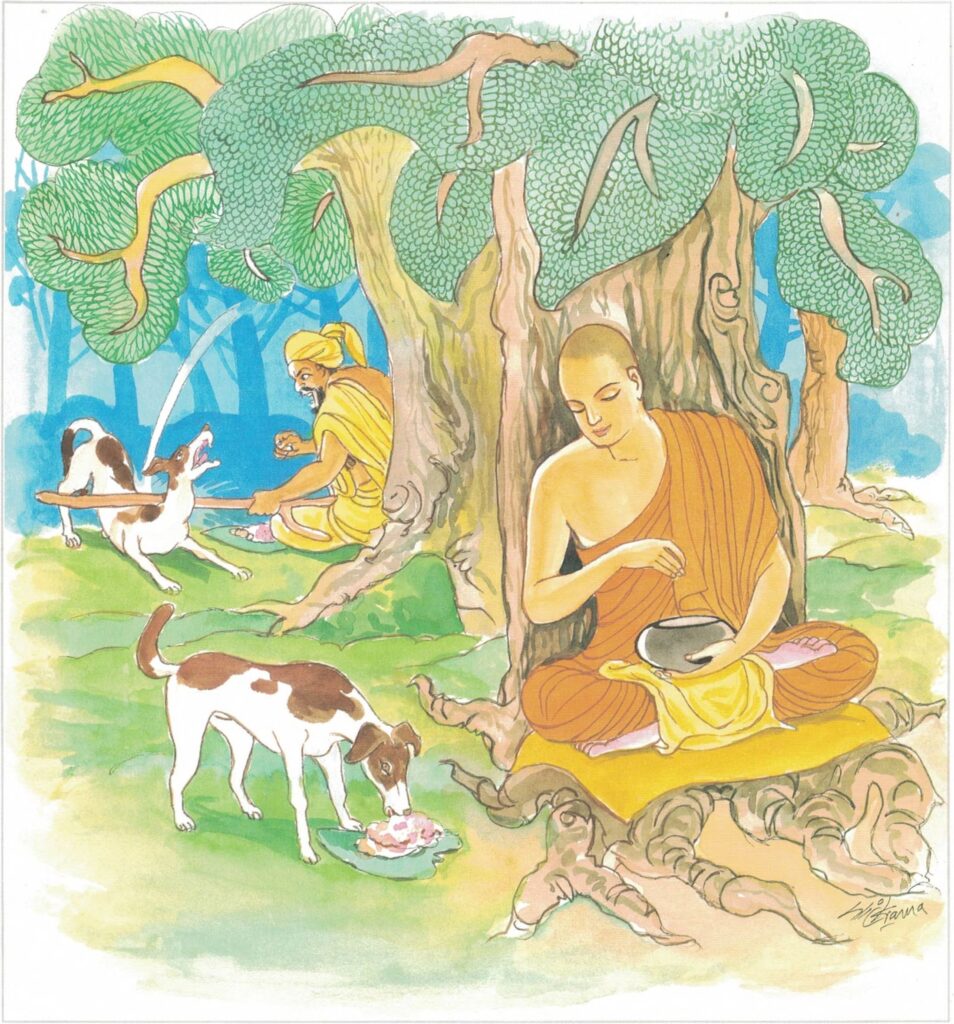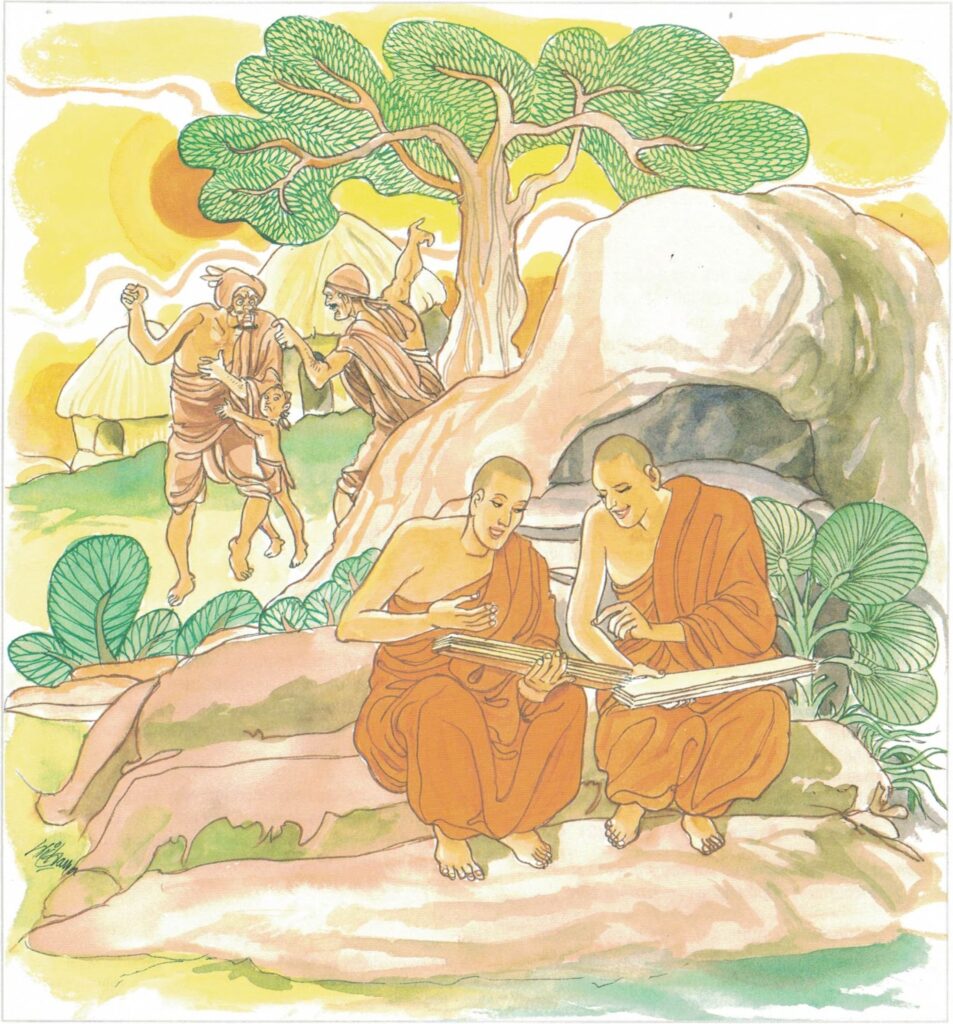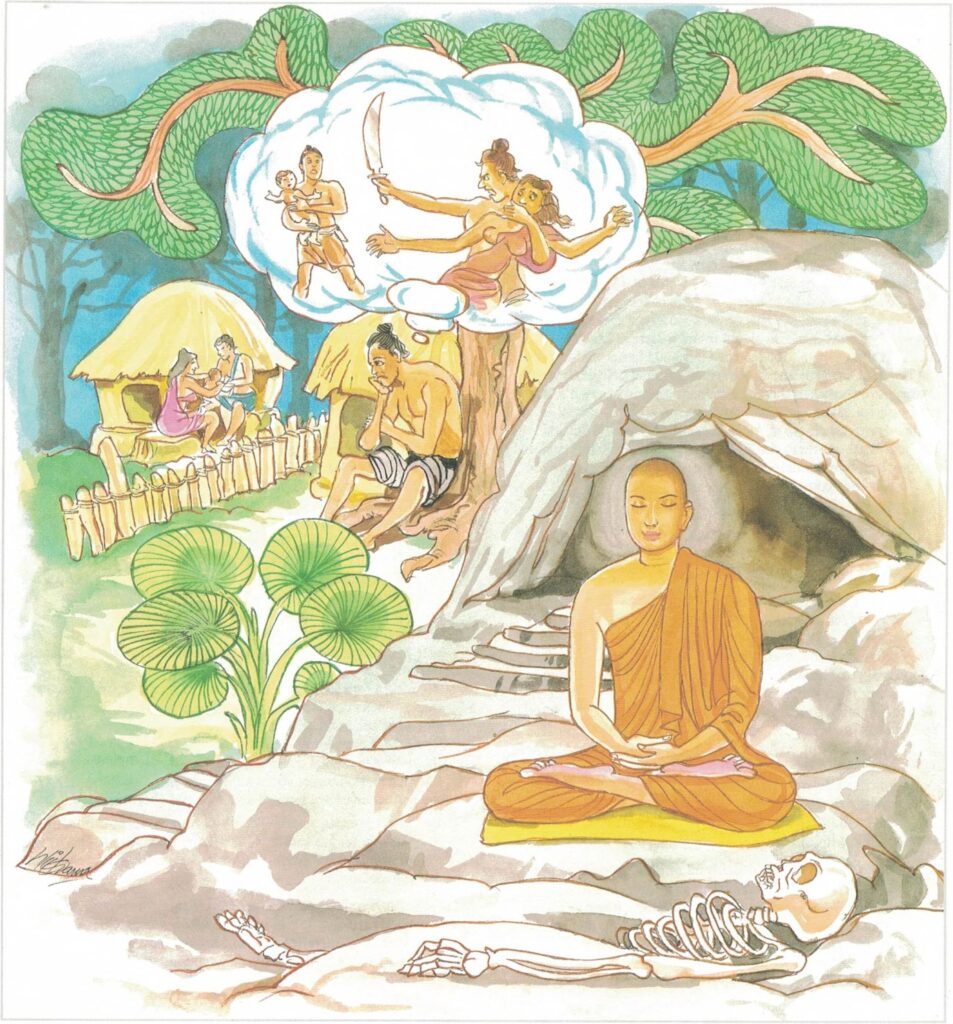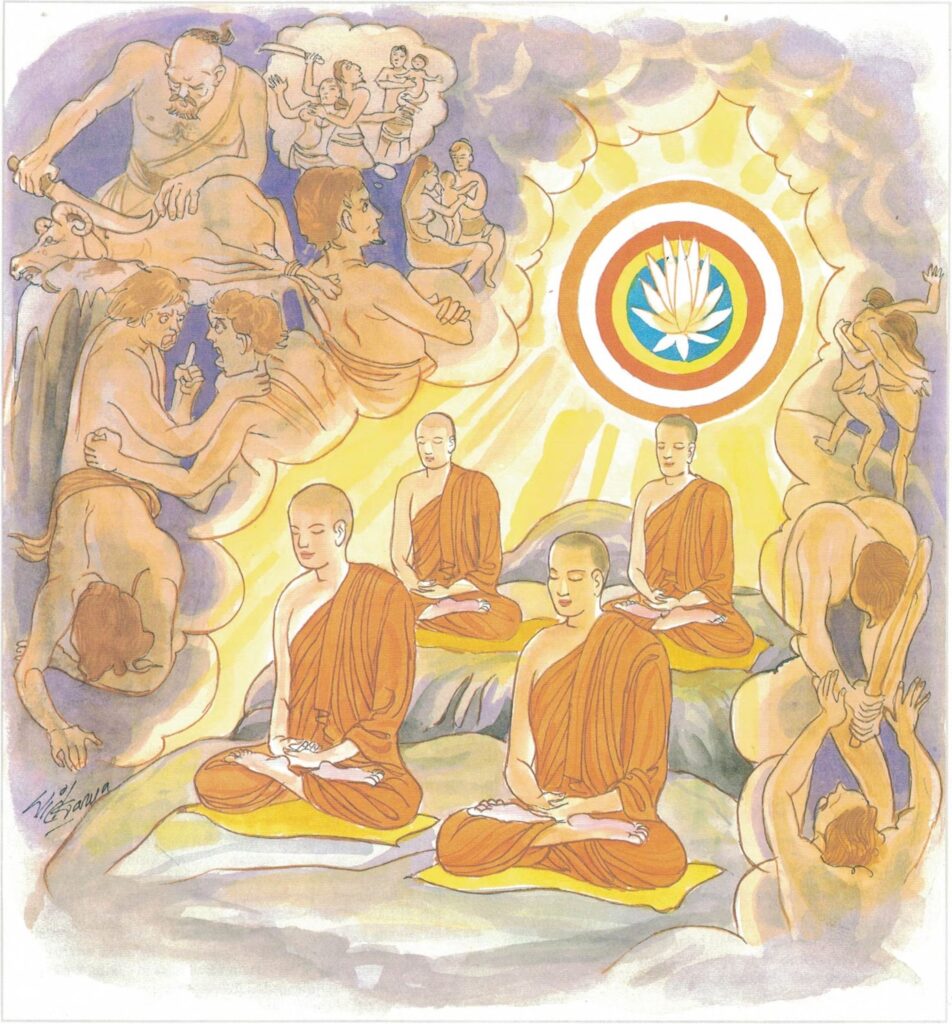Pali text, illustration and English translation of Dhammapada verse 231-234:
kāyappakopaṃ rakkheyya kāyena saṃvuto siyā |
kāyaduccaritaṃ hitvā kāyena sucaritaṃ care || 231 ||
vacīpakopaṃ rakkheyya vācāya saṃvuto siyā |
vacīduccaritaṃ hitvā vācāya sucaritaṃ care || 232 ||
manopakopaṃ rakkheyya manasā saṃvuto siyā |
manoduccaritaṃ hitvā manasā sucaritaṃ care || 233 ||
kāyena saṃvutā dhīrā atho vācāya saṃvutā |
manasā saṃvutā dhīrā te ve suparisaṃvutā || 234 ||
231. Rough action one should guard against, be with the body well-restrained, bad bodily conduct having shed train oneself in good.
232. Rough speaking one should guard against, be in speaking well-restrained, bad verbal conduct having shed train oneself in good.
233. Rough thinking one should guard against, be in thinking well-restrained, bad mental conduct having shed train oneself in good.
234. Restrained in body are the wise, in speech as well they are restrained, likewise are they restrained in mind, they’re perfectly restrained.




The Story of A Group of Six Monks
While residing at the Veluvana Monastery, the Buddha spoke these verses, with reference to a group of six monks.
For one day a band of six monks put wooden shoes on their feet, and taking staves of wood in their two hands, walked up and down on the surface of a flat rock. The Buddha hearing the clatter, asked Venerable Ānanda, “Ānanda, what is that noise?” The Venerable replied, “A band of six monks are walking about in wooden shoes; they are making the clatter you hear.” When the Buddha heard this, he promulgated the following precept, “A monk should control his deeds, his words, and his thoughts.”
Explanatory Translation (Verse 231)
kāyappakopaṃ rakkheyya, kāyena saṃvuto siyā,
kāya duccaritaṃ hitvā kāyena sucaritaṃ care.
kāyappakopaṃ [kāyappakopa]: excitement of body; rakkheyya: guard one’s self; kāyena saṃvuto siyā: be disciplined in body; kāya duccaritaṃ [duccarita]: bodily misconduct; hitvā: having given up; kāyena: with the body; sucaritaṃ care: behave virtuously
Guard against the physical expression of emotions. Be restrained in physical behaviour. Give up physical misconduct. Practice wholesome physical behaviour.
Explanatory Translation (Verse 232)
vacīpakopaṃ rakkheyya vācāya saṃvuto siyā
vacīduccaritaṃ hitvā vācāya sucaritaṃ care
vacīpakopaṃ [vacīpakopa]: excitement of speech; rakkheyya: guard one’s self; vācāya saṃvuto siyā: be disciplined in speech; vacīduccaritaṃ [vacīduccarita]: misconduct in speech; hitvā: having given up; vācāya: with your speech; sucaritaṃ care: behave virtuously
Guard against the verbal expression of emotions, Be restrained in your speech behaviour. Give up speech misconduct. Practise wholesome speech behaviour.
Explanatory Translation (Verse 233)
manopakopaṃ rakkheyya, manasā saṃvuto siyā,
manoduccaritaṃ hitvā manasā sucaritaṃ care
manopakopaṃ [manopakopa]: excitement of mind; rakkheyya: guard one’s self; manasā saṃvuto siyā: be disciplined in mind; manoduccaritaṃ [manoduccarita]: misconduct of mind; hitvā: having given up; manasā: with mind; sucaritaṃ care: practise good behaviour
Guard against the mental expression of emotions. Be restrained in the behaviour of your mind. Give up mental misconduct. Practise wholesome mental behaviour.
Explanatory Translation (Verse 234)
dhirā kāyena saṃvutā atho vācāya saṃvutā
manasā saṃvutā te dhīrā ve suparisaṃvutā
dhirā: those wise beings; kāyena: in body; saṃvutā: are disciplined; atho: again; vācāya: in speech; saṃvutā: are restrained; manasā: in mind; saṃvutā: are disciplined; te dhirā: those wise beings; ve: certainly; suparisaṃvutā: perfectly restrained
The wise are restrained in body. They are restrained in speech as well. They are also well disciplined in mind. They, who have safeguarded the three doors–body, speech and mind–are supremely restrained.
Commentary and exegetical material (Verse 231-234)
kāyappakopaṃ vacīpakopaṃ manopakopaṃ rakkheyya: guard against misdeed of body, speech, and mind. These stanzas were spoken by the Buddha to admonish a group of six monks whose behaviour was not in keeping with the discipline of monks. The Buddha asked them to guard themselves against misdeeds. The Buddhist system lays down strict rules to ensure that monks restrain themselves duly. If monks are to attain the higher stages of spiritual progress regulated behaviour is essential. These elementary principles of regulated behaviour are essential to one who treads the path to Nibbāna, chiefly because they tend to control both deeds and words. Violation of them introduces obstacles that hinder moral progress on the path. Observance of them means smooth and steady progress along the path.
Having progressed a step further in his gradual advance, the aspirant now tries to control his senses. To control craving for food and to promote meaning of mind and body, and fasting a day in the month is advisable. Simple living is preferable to a luxurious life which makes one a slave to passions. A life of celibacy is recommended, as one’s valuable energy thus conserved could then be utilised wholly for the intellectual and moral welfare of oneself and others. In such a life one is detached from additional worldly bonds that impede moral progress. Almost all spiritual teachers, it would appear, have nourished their bodies sparingly and have led a life of strict celibacy, simplicity, voluntary poverty, and self-control. While he progresses slowly and steadily, with regulated word and deed and sense-restraint, the kammic force of the striving aspirant compels him to renounce worldly pleasures and adopt the ascetic life.
To him then, comes the idea that:
A den of strife is household life,
And filled with toil and need,
But free and high as the open sky
Is the life the homeless lead.
Thus realizing the vanity of sensual pleasures, he voluntarily forsakes all earthly possessions, and donning the ascetic garb tries to lead a sagely life. It is not, however, the external appearance that makes a man holy but internal purification and an exemplary life. Transformation should come from within, not from without. It is not absolutely necessary to retire to solitude and lead the life of an ascetic to realize Nibbāna. The life of a monk no doubt expedites and facilitates spiritual progress, but even as a layman sainthood may be attained. He who attains arahatship as a layman in the face of all temptations is certainly more praiseworthy than a monk who attains arahatship living amidst surrounds that are not distracting.
Concerning a minister who attained arahatship while decked in his best apparel and seated on an elephant, the Buddha remarked:
Even though a man be richly adorned, if he walks in peace,
If he be quiet, subdued, certain and pure,
And if he refrains from injuring any living being,
That man is a Brāhmin, that man is a hermit, that man is a monk.
There have been several such instances of laymen who realized Nibbāna without renouncing the world. The most devout and generous layfollower Anāthapiṇḍika was a sotāpanna, the Sākya Mahānāma was a sakadāgāmi, the potter Ghatīkāra was an anāgāmi and King Suddhodana, the Buddha’s father, died as an arahat.
A monk is expected to observe the four kinds of higher morality–namely:
- Pātimokkha sīla—The Fundamental moral code,
- Indriyasamvara sīla—Morality pertaining to sense-restraint,
- Ājīvapārisuddhi sīla—Morality pertaining to purity of livelihood,
- Paccayasannissita sīla—Morality pertaining to the use of the necessaries of life.
These four kinds of morality are collectively called sīla-visuddhi (purity of virtue), the first of the seven stages of purity on the way to Nibbāna. When a person enters the order and receives his higher ordination (upasampadā), he is called a bhikkhu. There is no English equivalent that exactly conveys the meaning of this Pāli term bhikkhu. Mendicant monk may be suggested as the nearest translation, not in the sense of one who is begging but as one who lives on alms.
There are no vows for a monk. Of his own accord he becomes a monk to lead a religious life. He is at liberty to leave the Sangha. A monk is bound to observe 227 rules laid out in the Vinaya, apart from several other minor ones. The four major rules which deal with perfect celibacy, stealing, murder, and false claims to higher spiritual powers, must be strictly observed. If he violates any one of them, he becomes defeated (pārājikā) and automatically ceases to be a monk. If he wishes, he can re-enter the Sangha and remain as a sāmanera (novice). In the case of other rules which he violates, he has to make amends according to the gravity of the offence. Among the salient characteristics of a monk are purity, perfect celibacy, voluntary poverty, humility, simplicity, selfless service, self-control, patience, compassion, and harmlessness.
The life of a monk or, in other words, renunciation of worldly pleasures and ambitions, is only an effective means to attain Nibbāna, but is not an end in itself.
Securing a firm footing on the ground of morality, the aspirant then embarks upon the higher practice of samādhi, the control and culture of the mind, the second stage of the path of purity. Samādhi is equilibrium of the mind. It is stillness of the mind or the resting of mental activity. According to Buddhism, there are forty meditation topics (kammaṭṭhāna) which differ according to the temperaments of individuals.
They are:
(1) The ten expansions (kasinas), namely: (a) earth kasina, (b) water kasina, (c) fire kasina, (d) air kasina, (e) blue kasina, (f) yellow kasina, (g) red kasina, (h) white kasina, (i) light kasina and (j) space kasina.
(2) The ten disagreeables (asubha), namely ten corpses which are respectively: (a) bloated (uddhumātaka), (b) discoloured (vinīlaka), (c) festering (vipubbaka), (d) dissected (vicchiddaka), (e) gnawedto-pieces (vikkhāyitaka), (f) scattered-in-pieces (vikkhittaka), (g) mutilated and scattered-in-pieces (hatavikkhittaka), (h) bloody (lohitaka), (i) worm-infested (pulavaka), and (j) skeletal (aṭṭhika).
(3) The ten reflections (anussati), namely, eight reflections on: (a) the Buddha (Buddhānussati), (b) the Doctrine (Dhammānussati), (c) the Sangha (Sanghānussati), (d) virtue (sīlānussati), (e) liberality (cāgānussati), (f) devas (devātānussati), (g) peace (upasamānussati), (h) death (maranānussati), respectively, together with (i) mindfulness regarding the body (kāyagatāsati) and (j) mindfulness regarding respiration (ānāpānasati).
(4) The four immeasurables or the four modes of divine conduct (brāhmavihāra), namely, loving-kindness (mettā), compassion (karunā), appreciative joy (muditā), and equanimity (upekkhā).
(5) The one perception, i.e., the perception of the loathsomeness of material food (āhāre patikkiūlasaññā).
(6) The one analysis, i.e., the analysis of the four elements (catudhātuvivatthāna).
(7) The four arūpa jhānas, namely, the realm of the infinity of space (akāsānañcāyatana), the realm of the infinity of consciousness (viññānañcāyatana), and the realm of neither perception nor nonperception (n’eva saññā n’āsaññāyatana).
According to the texts, the ten impurities and the mindfulness regarding the body such as the thirty-two parts are suitable for those of a lustful temperament, because they tend to create a disgust for the body which fascinates the senses.
The four illimitables and the four coloured kasinas are suitable for those of a hateful temperament. The reflections on the Buddha and so forth are suitable for those of a devout temperament. The reflections on death and peace, perception on the loathsomeness of material food, and analysis of the four elements are suitable for those of an intellectual temperament. The remaining objects, chiefly reflection on the Buddha, meditation on loving-kindness, mindfulness regarding the body and reflection on death, are suitable for all, irrespective of temperament.
There are six kinds of temperaments (carita). They are:
- Lustful temperament (rāgacarita),
- Hateful temperament (dosacarita),
- Ignorant temperament (mohacarita),
- Devout temperament (saddhācarita),
- Intellectual temperament (buddhicarita), and
- Discursive temperament (vitakkacarita).
Carita signifies the intrinsic nature of a person which is revealed when one is in a normal state without being preoccupied with anything. The temperaments of people differ owing to the diversity of their actions or kamma. Habitual actions tend to form particular temperaments.
Rāga or lust is predominant in some, and dosa or anger, hatred, ill-will, in others. Most people belong to these two categories. There are a few others who lack intelligence and are more or less ignorant (mohacarita). Akin to the ignorant are those whose minds oscillate–unable to focus their attention deliberately on one thing (vitakkacarita). By nature some are exceptionally devout (saddhācarita), while others are exceptionally intelligent (buddhicarita).
Combining these six with one another, we get sixty-three types. With the inclusion of speculative temperament (diṭṭhicarita) there are sixtyfour types. The subjects of meditation are variously adapted to these different temperaments and types of people.
Before practicing Samādhi, the qualified aspirant should give careful consideration to the subject of meditation. In ancient days it was customary for pupils to seek the guidance of a competent teacher to choose a suitable subject according to their temperaments. But today, if no competent teacher is available the aspirant must exercise his own judgement and choose one he thinks most suited to his character.
When the subject has been chosen, he should withdraw to a quiet place where there are the fewest distractions. The forest, a cave, or any lonely place is most desirable, for there one is least liable to interruption during the practice.
It should be understood that solitude is within us all. If our minds are not settled, even a quiet forest would not be a congenial place. But if our minds are settled, even the heart of a busy town may be congenial. The atmosphere in which we live acts as an indirect aid to tranquillize our minds. Next to be decided by the aspirant is the most convenient time when he himself, and his surroundings, are in the best possible condition for the practice.
Early in the morning, when the mind is fresh and active, or before bedtime, if one is not overtired, is generally the most appropriate time for meditation. But whatever the time selected it is advisable to keep to that particular hour daily, for our minds then become conditioned to the practice.
The meditating posture, too, serves as a powerful aid to concentration. Meditators generally sit cross-legged, with the body erect. They sit placing the right foot on the left thigh and the left foot on the right thigh. This is the full position. If this posture is difficult, as it certainly is to many, the half position may be adopted, that is, simply placing the right foot on the left thigh or the left foot on the right thigh. When this triangular position is assumed, the whole body is well balanced. The right hand should be placed on the left hand, the neck straightened so that the nose is in a perpendicular line with the navel, the tongue should rest on the upper palate. The belt should be loosened, and clothes neatly adjusted. Some prefer closed eyes so as to shut out all unnecessary light and external sights. Although there are certain advantages in closing the eyes, it is not always recommended as it tends to drowsiness. Then the mind gets out of control and wanders aimlessly, vagrant thoughts arise, the body loses its erectness, quite unconsciously the mouth opens itself, saliva dribbles, and the head nods. The Buddha usually sat with half closed eyes looking through the tip of the nose and not more than a distance of four feet away.
Those who find the cross-legged posture too difficult may sit comfortably in a chair or any other support, sufficiently high to rest the feet on the ground. It is of no great importance what posture one adopts provided it is easy and relaxed. The aspirant who is striving to gain onepointedness of the mind should endeavour to control any unwholesome thoughts at their very inception.
As mentioned in the Sutta Nipāta he may be attacked by:
- sensual desires (kāma),
- dissatisfaction (arati),
- hunger and thirst (khuppipāsā),
- urge (tanhā),
- sloth and torpor (thīnamiddha),
- fear (bhaya),
- doubt (vicikicchā),
- detraction and stubbornness (makkha, thambha),
- gain, praise, honour and ill-gotten fame (lobha, siloka, sakkāra, micchāyasa), and
- self-praise and contempt for others (attukkamsana paravambhana).
On such occasions the following practical suggestions were given by the Buddha to be of benefit:
(1) Harbouring a good thought opposite to the encroaching one: loving-kindness in cases of hatred.
(2) Reflecting upon possible evil consequences: anger that results in ill-will.
(3) Simple neglect or becoming wholly inattentive to them.
(4) Tracing the cause which led to the arising of the unwholesome thoughts and thus forgetting them in the retrospective process.
(5) Direct physical force.
Just as a strong man overpowers a weak person, so one should overcome evil thoughts by bodily strength. “With teeth clenched and tongue pressed to the palate,” advises the Buddha, “a man by main force must constrain and coerce his mind.”
The essence of Buddhism: These stanzas, in which the Buddha provided practical guidelines to a group of unruly monks, establish the essential quality of the Buddha’s Teaching. The central focus of Buddhism is practice. One must live the Teachings if one is to achieve the highest spiritual goals of Buddhism.
Buddhism is neither a metaphysical path nor a ritualistic path:
It is neither skeptical nor dogmatic.
It is neither eternalism nor nihilism.
It is neither self-mortification nor self-indulgence.
It is neither pessimism nor optimism but realism.
It is neither absolutely this-worldly nor other-worldly.
It is not extrovert but introvert.
It is not theo-centric but ego-centric.
It is a unique Path of Enlightenment.
The original Pāli term for Buddhism is Dhamma, which, literally, means that which upholds or sustains (he who acts in conformity with its principles and thus prevents him from falling into woeful states).